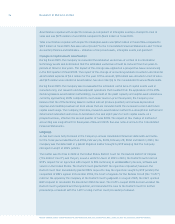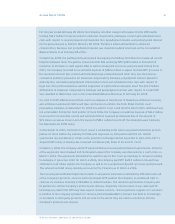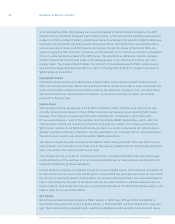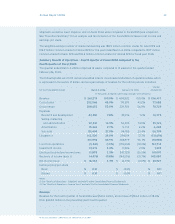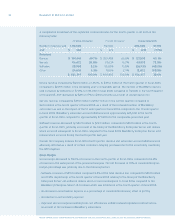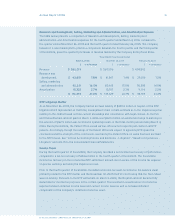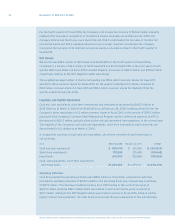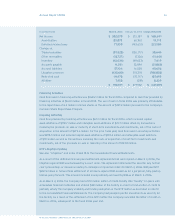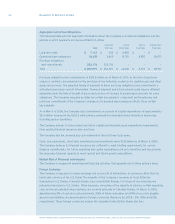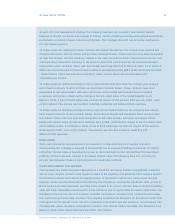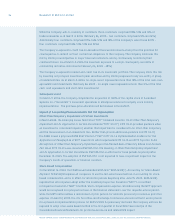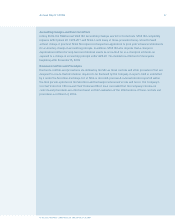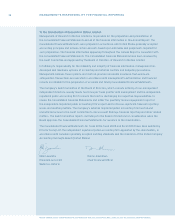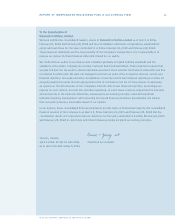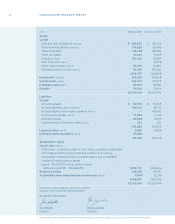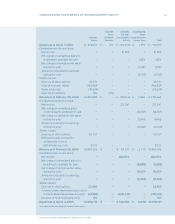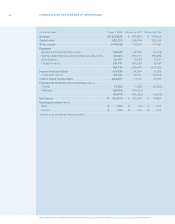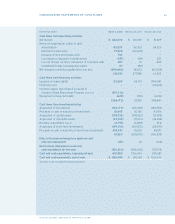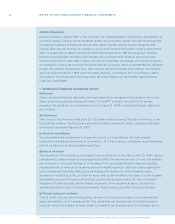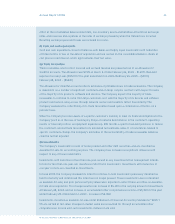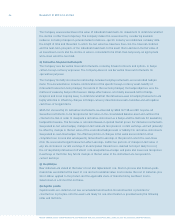Blackberry 2006 Annual Report Download - page 38
Download and view the complete annual report
Please find page 38 of the 2006 Blackberry annual report below. You can navigate through the pages in the report by either clicking on the pages listed below, or by using the keyword search tool below to find specific information within the annual report.
Research In Motion Limited
36
Research In Motion Limited • Incorporated Under the Laws of Ontario (In thousands of United States dollars, except per share data, and except as otherwise indicated)
While the Company sells to a variety of customers, three customers comprised 18%, 13% and 13% of
trade receivables as at March 4, 2006 (February 26, 2005 — two customers comprised 23% and 12%).
Additionally, four customers comprised 19%, 16%, 12% and 12% of the Company’s sales (scal 2005 —
four customers comprised 14%, 13%, 13% and 10%).
The Company is exposed to credit risk on derivative nancial instruments arising from the potential for
counterparties to default on their contractual obligations to the Company. The Company minimizes this
risk by limiting counterparties to major nancial institutions and by continuously monitoring their
creditworthiness. As at March 4, 2006 the maximum exposure to a single counterparty was 40% of
outstanding derivative instruments (February 26, 2005 – 38%).
The Company is exposed to market and credit risk on its investment portfolio. The Company limits this risk
by investing only in liquid, investment grade securities and by limiting exposure to any one entity or group
of related entities. As at March 4, 2006, no single issuer represented more than 12% of the total cash, cash
equivalents and investments (February 26, 2005 – no single issuer represented more than 9% of the total
cash, cash equivalents and short-term investments).
On March 9, 2006, the Company completed the acquisition of 100% of the capital stock of Ascendent
Systems Inc. (“Ascendent”). Ascendent specializes in enterprise solutions to simplify voice mobility
implementations. The purchase price allocation will be nalized in scal 2007.
Impact of Accounting Pronouncements Not Yet Implemented
In March 2004, the Emerging Issues Task Force (“EITF”) released Issue No. 03-01
Other-Than-Temporary
Impairment and its Application to Certain Investments
(“EITF 03-01”). EITF 03-01 provided guidance when
an investment is considered impaired, whether that impairment is considered to be other-than temporary,
and the measurement of an impairment loss. Rather than provide additional guidance on EITF 03-01,
the FASB issued a proposed FASB Staff Position (“FSP”) EITF 03-1-a
Implementation Guidance for the
Application of Paragraph 16 of EITF Issue 03-01
, which superseded EITF 03-01 and EITF Topic No. D-44,
Recognition of Other-Than-Temporary Impairment upon the Planned Sale of Security Whose Cost Exceeds
Fair Value
. EITF 03-01-a was renamed FSP FAS 115-1
The Meaning of Other-Than-Temporary Impairment
and its Application to Certain Investments
. FSP FAS 115-1 is effective for scal periods beginning after
December 15, 2005. The adoption of FSP FAS 115-1 is not expected to have a signicant impact on the
Company’s results of operations or nancial condition.
On December 16, 2004, the FASB issued amended SFAS 123 (“SFAS 123(R)”)
Accounting for Share-Based
Payment
. SFAS 123(R) requires all companies to use the fair-value based method of accounting for stock-
based compensation, and is in effect for all interim periods beginning after June 15, 2005. SFAS 123(R)
requires that all companies adopt either the modied prospective transition (“MPT”) or modied
retrospective transition (“MRT”) method. Stock compensation expense calculated using the MPT approach
would be recognized on a prospective basis in the nancial statements over the requisite service period,
while the MRT method allows a restatement of prior periods for amounts previously recorded as proforma
expense. On April 14, 2005, the U.S. Securities and Exchange Commission announced that it would provide
for a phased-in implementation process for SFAS 123(R). As previously disclosed, the Company will now be
required to adopt a fair-value based method in the rst quarter of scal 2007. See note 1(u) of the
Consolidated Financial Statements for proforma disclosure and related EPS impact.


